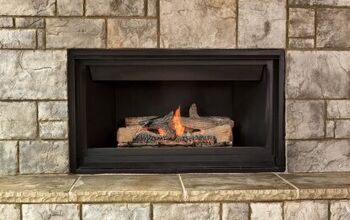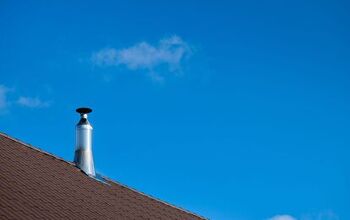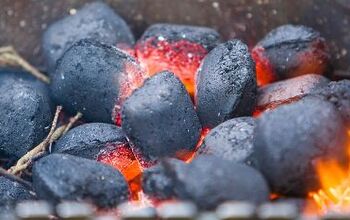Can You Drywall Around A Gas Fireplace? (Find Out Now!)

Gas fireplaces are convenient sources of heat that are both easy to use and efficient. In fact, some gas fireplace units offer over 90 percent efficiency with minimal additional costs for operation. Like all fireplaces or other devices that give off heat, there are specific code requirements that must be met. It’s imperative that you are able to recognize potential safety hazards and fix them to ensure the safety of your home and your family.
For instance, you may find yourself wondering: “Can you drywall around a gas fireplace?” When installing a fireplace, it’s crucial that you adhere to the proper clearance of combustibles. Placing a combustible material, such as drywall, too close to your gas fireplace can cause a house fire.
Although clearances may vary based on the manufacturer, the National Fire Code requires that all combustible material be at least six inches from the opening of the firebox – this includes drywall. In the fireplace world, even fire-rated drywall is considered to be combustible and should be installed with the necessary clearance. Combustible framing, on the other hand, must not be placed with two inches of the exterior face of a masonry fireplace or less than six inches from the interior surface of the adjacent flue lining.
The only instance in which it is acceptable to install drywall around a fireplace is when you have a zero clearance fireplace. However, clearance requirements can vary considerably based on the manufacturer. With that said, we’ll go over the proper clearances and some general best practices to avoid potential safety hazards with your gas fireplace.
Do You Need Brick or Stone Fireplace Installation?
Get free, zero-commitment quotes from pro contractors near you.

What Does Clearance to Combustible Materials Mean?
‘Combustibles’ are defined as “normal construction materials” and essentially refer to any material or surface that has the potential to burn. This includes particleboard, wood framing materials, millboard, plywood paneling, plywood sub-flooring, wood flooring, plant fibers compressed paper, mantels, wood trim, plastics, and drywall.
Whether flameproofed or not, plastered or un-plastered, a combustible is any material that could ignite and burn. It’s crucial that fireplaces are properly installed with the necessary clearances – or, the distance that is deemed safe between a heat-producing device, vent pipe, chimney, chimney liner, vent connector, or other hot surfaces and flammable materials.
Accounting for the proper clearances helps to avoid heat-caused chemical decomposition, via a process called pyrolysis. Although all gas fireplaces come with varying requirements from the manufacturer, there are some standard rules you should consider when installing one in your home. As always, it’s highly advisable that you consult the installation manual from your manufacturer for specific requirements.
Masonry Fireplaces vs. Zero-Clearance Fireplaces
When it comes to determining whether or not you can drywall around a gas fireplace, you must know whether the fireplace is zero clearance or masonry built. The most obvious difference between the two types is their construction.
Put simply, masonry fireplaces are an architectural component that is structurally assimilated into your home, while factory-built zero-clearance fireplaces are constructed offsite and installed into your home later.
Let’s explore the differences in detail to further understand allowable clearances to combustible materials.
Masonry Fireplaces
Masonry fireplaces have been seen in both traditional and contemporary homes for centuries. When a home is built, these fireplaces are integrated into the architecture and become a major part of the structural design. Some of the main characteristics of masonry fireplaces are as follows:
- Structurally incorporated into the home
- Constructed out of brick and mortar or stone
- Durable design
- Concrete foundation
- More expensive to build and repair
Though somewhat expensive to install, masonry fireplaces tend to have a pretty long lifespan – assuming they are properly maintained and inspected on a regular basis and repaired as needed.
Masonry Fireplace Clearances
When it comes to masonry fireplace clearances, all combustible materials must be kept approximately six inches from the firebox opening. Combustible framing – including anything that’s made of wood – must not be placed within two inches of the masonry fireplace’s exterior face and not less than six inches from the interior surface of the adjacent flue lining.
Combustible materials and wood framing must also not be installed within two inches of the fireplace’s back surface. While these clearances are a good rule of thumb, always check your manufacturer’s installation manual for specific framing guidelines. Clearances tend to vary based on manufacturers and also the quality of the material used.
Zero Clearance Fireplaces
Zero clearance fireplaces are factory-built fireboxes that are specially designed and fire-rated so that no clearance is needed between the firebox and construction materials. These pre-manufactured fireplaces have the ability to be installed almost directly against combustible materials such as wood, paneling, and even drywall.
This has to do with the fact that both the materials of the firebox and the construction of the fireplace do not allow the exterior temperatures of the firebox to impact these materials. Zero clearance fireplaces also do not require a hearth, a chimney for venting, and can either be vented through an exterior wall or through your ceiling.
The major advantage to these fireplaces is that they can be installed in a home after it has been built and without the need for a major remodel. Some of the distinguishing characteristics of these zero clearance fireplaces include:
- More affordable to install than masonry fireplaces
- Independent of your home’s structure
- Constructed of metal, glass, insulated walls, and air-cooled piping
- Shorter lifespan
Like masonry fireplaces, zero clearance fireplaces are also regulated and must be built according to engineering codes. This gives you peace of mind knowing that these units are safe for you, your family, and your home. Though, it’s still recommended that you have these fireplaces installed by a qualified expert.
Framing a Zero Clearance Gas Fireplace
In regards to framing a zero clearance fireplace, drywall can extend flush with the appliance on the sides and bottom of the fireplace. However, it’s advised that a non-combustible material be used to extend flush with the top of the fireplace. This material must have a vertical length that is equivalent to the height of the standoffs.
If you’re installing a zero clearance fireplace in a cold climate, it is recommended that the outer walls be insulated when installing against non-insulated exterior walls. Drywall should be implemented around the unit to avoid insulation from contacting the body of the unit.
Follow the table below for clearance to combustibles for zero clearance fireplaces:
| Back (from standoffs) | 0 inches |
| Top (from standoffs) | 0 inches |
| Floor | 0 inches |
| Top (from standoffs) | 0 inches |
| Top (from front of unit) | 2.5 inches |
| Top of 90 Degree Bend | 4 inches |
| Top of Horizontal Pipe | 2.5 inches |
Do You Need Brick or Stone Fireplace Installation?
Get free, zero-commitment quotes from pro contractors near you.

Can You Drywall Around a Gas Fireplace?
In short, the only instance where you can drywall around a gas fireplace is if the unit is a zero clearance, factory-built fireplace. These appliances are specifically designed to be installed almost directly against combustible materials. When it comes to masonry gas fireplaces, drywall can only be installed at least six inches from the opening of the fireplace.
Again, clearance recommendations will vary based on the manufacturer so make sure that you check your installation manual for specifics. When in doubt, consider consulting the help of a professional. A certified professional in your area will be aware of the local and national codes that must be met.

Jessica considers herself a home improvement and design enthusiast. She grew up surrounded by constant home improvement projects and owes most of what she knows to helping her dad renovate her childhood home. Being a Los Angeles resident, Jessica spends a lot of her time looking for her next DIY project and sharing her love for home design.
More by Jessica Stone


















![10 Most Dangerous Neighborhoods in Baltimore [Updated]](https://cdn-fastly.upgradedhome.com/media/2023/07/31/9075655/10-most-dangerous-neighborhoods-in-baltimore-updated.jpg?size=350x220)








